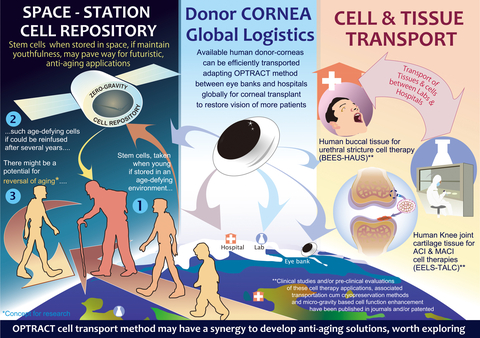TOKYO

A much efficient human cadaver donor-corneal transportation method, developed by Japanese scientists, may increase the availability of donated eyes to millions of patients with corneal blindness, waiting for corneal transplantation restoring vision. The OPTRACT method, better preserving human buccal tissue and cartilage during transport between hospitals and laboratories, reverses cellular aging, beside being granted a Japanese patent for functional enhancement of immune cells under micro-gravity. These accomplishments harbinger a futuristic strategy of evaluating the implications of inter-stellar environments on human cells aboard a space station without gravity, which if defies aging related damages, may yield solutions to frailty of aging, researchers opine.
This press release features multimedia. View the full release here: https://www.businesswire.com/news/home/20220302006156/en/

A cell repository aboard a space station in zero gravity or in a micro gravity of other planets or inter-stellar space, in which, if aging related implications or damages to cells could be alleviated, storing human stem cells for certain duration, with suitable gravitational forces and then re-infusion, might yield restoration of youth. Accomplishments by OPTRACT method-based transportation of cells and tissues between hospitals and laboratories for regenerative medicine – cell therapy applications, human cadaver corneal transportation across destinations and cryopreservation of stem cells; several published by the Japanese scientists and granted patents, have paved way to these futuristic research strategies of space-age anti-aging solutions. The OPTRACT method based in vitro culture has yielded reversal of senescence of human chondrocytes in the lab, employing proprietary tissue engineering techniques. (Graphic: Business Wire)
Cell therapies in regenerative medicine involve tissue harvesting in hospitals, transporting to cell processing facilities, isolating, culturing cells, and preserving for varying durations until transplantation to patients.
Scientists with Inter-disciplinary expertise have accomplished the following path-breaking solutions, using chemically concocted polymer scaffolds:
- Human cadaver donor corneal transport with better preservation of corneal endothelial density: https://doi.org/10.1007/s10529-021-03116-y
- Preservation and transportation of human buccal mucosa for male urethral stricture treatment: https://doi.org/10.1089/bio.2021.0079
- Cartilage transport for ACI & MACI cell therapies, to treat knee joint damage: https://doi.org/10.1016/j.jor.2022.01.007
- Corneal endothelial logistics without cold chain (https://pubmed.ncbi.nlm.nih.gov/24008800/) and treatment of bullous keratopathy: https://www.ncbi.nlm.nih.gov/pmc/articles/PMC5840311/
- Microgravity, enhancing nitric oxide, a weapon of immune cells to destroy cancer: Japan patent: 6757578/2020
- Cryopreservation of bone marrow and cord blood stem cells: Japan patent: 6373241/2018
Having proven phenotype maintenance and better viability of human cells and tissues under varying temperatures outside the body, enhancement of natural killer cells and reversal of cellular senescence in the lab (https://doi.org/10.1038/s41598-021-93607-9), they envision studying cell biology and epigenetics in the zero-gravity environment of a space station, to which cells could be transported and stored, if proven mitigating senescence, that may yield cues to anti-aging solutions, they propose.
“Time has come for a dream project of cell-repository aboard a space-station, with like-minded institutes, which may herald the birth of a novel, space-age anti-aging medicine”, comments Dr. Shojiro Katoh, President, Edogawa Hospital, with beaming hope, as his collaborators appreciated a wholesome ecosystem in Japan, enabling development of novel solutions, its synergy with inter-disciplinary expertise and global network of GN Corp and support from JBM Inc.
https://sponsored.bloomberg.com/article/jco/japan-where-high-tech-meets-high-value-foreign-direct-investment
View source version on businesswire.com: https://www.businesswire.com/news/home/20220302006156/en/
CONTACT
Samuel JK Abraham
info@gncorporation.com





